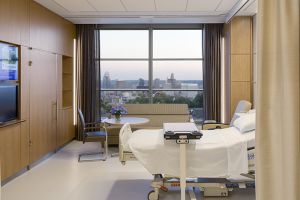Engineering solutions for hospital noise

Early planning ensured noise mitigation strategies were incorporated into the Harris Health System's new Lyndon B. Johnson Hospital.
Image courtesy of HKS Architects
Hospitals are noisy places. Footsteps in the hallway, conversations outside patient rooms, alerts from medical equipment and staff communicating through mobile devices all add to the noise level. For patients trying to rest and recover, the constant noise can be disruptive and exhausting. This experience is often reflected in Hospital Consumer Assessment of Healthcare Providers and Systems (HCAHPS) surveys. When answers to questions such as, “How often was the area around your room quiet at night?" are negative, it can contribute to a low score in the hospital environment category. As hospitals continue to prioritize patient experience, addressing environmental noise is becoming an operational focus. This affects more than comfort because patient satisfaction scores influence both public perception and reimbursement.
Since the implementation of the Centers for Medicare & Medicaid Services’ Hospital Value-Based Purchasing (VBP) program, a portion of Medicare payments has been tied to patient satisfaction metrics, including HCAHPS scores. The VBP program includes five domains: mortality and complications, health care-associated infections, patient safety, patient experience, and efficiency and cost reduction. Currently, the patient experience domain — under which the HCAHPS “quiet at night” metric falls — accounts for 25% of a hospital's total performance score within the VBP program.
The challenges to achieving ‘quiet at night’
For hospitals, design decisions must first be driven by clinical priorities. This makes focusing on acoustic improvements complex. Here are the challenges that work against health care facilities managers in achieving higher scores in the HCAHPS survey’s “quiet at night” ratings:
Noise mitigation. Sound is often generated inches from the patient’s ear. Alarms, monitoring devices and other clinical equipment are located at the bedside for safety and speed. Because the source of the noise is so close, traditional sound-absorbing strategies have limited impact.
Surfaces. Materials that support infection control tend to work against acoustic comfort. Smooth walls, hard flooring and cleanable ceilings are effective at maintaining hygiene, but they reflect sound rather than absorb it. In patient rooms and corridors, this creates spaces where noise lingers and travels.
Building infrastructure. Mechanical design choices are shaped by health and safety. Hospitals circulate large volumes of fresh air to reduce the risk of infection. Because of the need for high air change rates, fans, ductwork and air-handling units generate consistent noise. In many cases, internal duct linings that would reduce sound are avoided due to concerns about contamination, especially where clean air is involved.
Environmental services. Regular cleaning adds to the problem. Door seals play a role in limiting noise transfer between spaces. Yet in hospitals, the strong disinfectants used by environmental services (EVS) teams can wear down these seals over time, creating gaps that let sound pass through more easily. These challenges add up, and when asked about them on the HCAHPS survey, patients notice.
Evidence-based solutions
Evidence-based design offers practical strategies that reduce noise, support privacy and align with infection control and code requirements. From early-stage planning to material selection and retrofit-friendly technologies, each strategy and solution used should be grounded in proven positive outcomes.
Early planning. Noise control in hospitals is most effective when integrated into early design stages, whether for new construction or renovations. Strategies like offsetting doorways, using storage rooms or corridors as acoustic buffers and separating high-activity zones from patient care areas can significantly reduce sound transfer. These design choices often require minimal additional construction cost but have a measurable impact on acoustic performance and patient satisfaction.
For critical care areas, extending walls to the structural deck rather than stopping at the ceiling can further limit sound transmission. This approach prevents noise from traveling through shared plenum spaces, improving patients' privacy and sleep quality. Limiting air circulation between rooms also can support infection control strategies.
For the new University of Texas MD Anderson Cancer Center project in Sugar Land, Texas, most of the major mechanical systems were placed in a courtyard that was structurally independent from the building. This additional distance between the equipment and the separate structure allowed engineers to address the noise and vibration control of these units much more economically.
Material and component selection. In health care environments, materials must perform across several domains. Acoustics, infection control, durability and code compliance all shape product selection. Solutions are available that meet multiple requirements to allow hospitals to maintain regulatory standards without compromising the patient experience.
Mechanical noise is one of the most persistent acoustic challenges. Duct-borne sound can be reduced using packless silencers, which dampen noise without traditional fiber linings that may raise hygiene concerns. Additional measures include selecting quieter air-handling units; specifying thicker, heavier metal for ductwork; or wrapping large ducts with mass loaded vinyl to prevent breakout noise — all approaches that can be adapted to infection-sensitive areas.
Interior finishes also influence noise levels. Hospital-specific brands of acoustic ceiling tiles are available with high noise reduction coefficients that withstand the hospital-grade disinfectants increasingly used in patient rooms, corridors and nurse stations. These materials help reduce reverberation while maintaining environmental hygiene.
Flooring materials impact noise, as well. In corridors and clinical areas, luxury vinyl tile provides durability, cleanability and reduced footfall noise. In surgical or procedural spaces, products with integrated acoustic underlayments can minimize impact sound without compromising infection control protocols.

Interior surfaces at Lyndon B. Johnson Hospital were selected based on acoustic comfort and other factors.
Image courtesy of HKS Architects
At Harris Health System Lyndon B. Johnson Hospital in Houston, the design team worked closely with facilities and infection prevention leaders to evaluate each product’s acoustic performance alongside its maintenance profile and regulatory fit. The result was an environment that supported clinical standards and improved acoustic comfort for patients and staff.
Demountable partitions. Demountable partition systems offer needed flexibility in hospitals, particularly as space needs shift over time. However, even systems with sound transmission class ratings above 45 may fall short if installation details are overlooked. Sound can bypass partitions through gaps at floor, ceiling and wall intersections — especially when paired with lightweight ceiling tiles.
To improve acoustic performance, full-height installations that extend to the structural deck are recommended in sensitive areas. While more costly, they provide better privacy and sound containment, especially in consult rooms, behavioral health areas and shared clinical spaces.
Gaskets and seals must be maintained. Over time, these components can degrade through EVS protocols, diminishing the partition’s effectiveness. For demountable partition solutions to work long-term, they require regular inspection and replacement of gaskets and seals to maintain performance.
For the Lyndon B. Johnson Hospital, engineers met with the administration and discussed previous post-occupancy evaluations of other facilities to identify spaces where the demountable conditions created more challenges and where they were generally acceptable. Using this information, in concert with the Facility Guidelines Institute’s Guidelines, the engineers were able to provide counsel and manage expectations for the use of demountable partitions.
Sound masking systems
Unlike architectural or material interventions that require planning during construction, sound masking systems can be implemented at any stage, making them especially valuable in existing hospital environments. These systems emit a low-level, consistent background sound that reduces the perceptibility of sudden noises, such as alarms, conversations or equipment use. Rather than eliminating noise, they elevate the ambient sound level in a controlled manner, making disruptive sounds less jarring to patients.
In addition to improving comfort, sound masking systems support privacy goals. By limiting the intelligibility of speech, they help reduce the likelihood of sensitive conversations being overheard in areas like patient rooms, nurse stations and reception areas. This function supports compliance with privacy regulations such as the Health Insurance Portability and Accountability Act in the United States and the Personal Information Protection and Electronic Documents Act in Canada.
Because they can be integrated into existing facilities without major disruption, sound masking systems offer hospitals a practical, scalable strategy for improving the acoustic environment while addressing both comfort and confidentiality.
Sound masking systems were included at the Grace Health System in Lubbock, Texas, both within patient rooms and in corridors. Patient rooms were set at a lower level to provide a more consistent noise level and minimize the jarring sounds of alarms, while corridors were set at a higher level to reduce speech intelligibility and provide privacy for patients.
Taking steps to achieve better ‘quiet at night’ scores
Often, when a new build or expansion project begins, no one talks about the “quiet at night” metric. But when the low HCAHPS scores arrive, it’s one of the hardest issues to fix after the fact.
In many health care projects, acoustics are either addressed late or overlooked entirely. By the time flooring, wall assemblies, mechanical layouts and room adjacencies are finalized, the most cost-effective and impactful opportunities to manage noise have already passed. What follows is a reactive approach: troubleshooting complaints, retrofitting materials and working around systems that were never designed with acoustic performance in mind.
This is where collaboration changes the outcome. When health care facilities managers, architects, engineers and infection prevention teams work together from the start and include an experienced acoustician in the conversation, it’s possible to identify the most strategic interventions early. An acoustician can help determine what’s worth doing, where it should be done and how it fits within the real-world constraints of hospital operations.
But new-builds and renovations don’t happen every day. Most health care facilities managers are dealing with existing facilities, where a phased approach is often the most realistic path forward. Prioritizing high-impact improvements, like door seal maintenance, sound masking systems or mechanical noise control, can make a measurable difference. Small renovations also may include upgrading the ceiling system to a high ceiling attenuation class system or adding layers of drywall to existing partitions.
Facilities managers are uniquely positioned to lead this work. They understand not only how their buildings operate but also how small changes in the environment ripple outward into patient satisfaction, clinical effectiveness and operational success. A layered approach can improve outcomes across the board.
The “quiet at night” score may not be top of mind all the time. But with the right expertise and a collaborative team, it doesn’t have to be an unsolvable problem.
Alex Hornecker, INCE Bd Cert, is a senior consultant, and Courtney Schoedel, M.Arch, M.Sc, INCE Bd Cert, LEED AP, is vice president at Salas O’Brien. They can be reached at alex.hornecker@salasobrien.com and courtney.schoedel@salasobrien.com.




